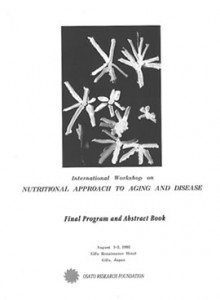| Title | Abstinence-Induced Oxidative Stress in Alcoholics is Improved by Bio-Normalizer |
|---|---|
| Year | 1995 |
| Author | F. Marotta; P. Sarfan; J.A. Osato; G.I. Serv |
| Publisher | International Workshop on Nutritional Approach to Aging and Disease |
International Workshop on
NUTRITIONAL APPROACH TO AGING AND DISEASE
Final Program and Abstract Book
August 1-3, 1995
Gifu Renaissance Hotel
Gifu, Japan
OSATO RESEARCH FOUNDATION
Abstinence-induced Oxidative Stress in Alcoholics
is Improved by Bio-Normalizer
F. Marotta, *P. Safran, +J.A.Osato, G.I. Serv., S. Anna Hosp., Como, Italy;
*Econum, Villeneuve d’ Ascq, France; Sun-O Intl. Inc., Gifu, Japan
There is a paucity of data on the recovery from oxidative stress after cessation of ethanol in longstanding alcoholics. The aim of this study was to address such issue by further testing Bio-normalizer (BN), a natural product with antioxidant properties. Twelve alcoholics (<80g ethanol/day for at least 3 years) who had just stopped drinking, as assured by blood sampling, were randomly allocated into two 1-week treatment groups; A) daily supply of 9g of BN orally at bedtime; B) 9g of placebo. A home dietary record was obtained and no vitamins supplementation was allowed. Blood was daily checked for: TBARS, SOD, the ratio between the isomers of linoleic acid (CDR%) and routine liver function tests. Baseline data were comparable between groups at the entry into the study. As compared to early >25% TBARS increase in B, A group showed a significant decrease (p<0.01 ) of TBARS and CDR% ratio. Both values remained lower throughout the study period. SOD showed an early increase in group A (p<0.05 vs B) with normalization at 1-week. No change appeared in routine tests between the two groups. These data point out the persistence of oxidative stress after ethanol abstinence. Further, BN a product endowed also with antioxidant property, when orally administered, is able to fasten the early recovery process, thing of potential clinical application.
